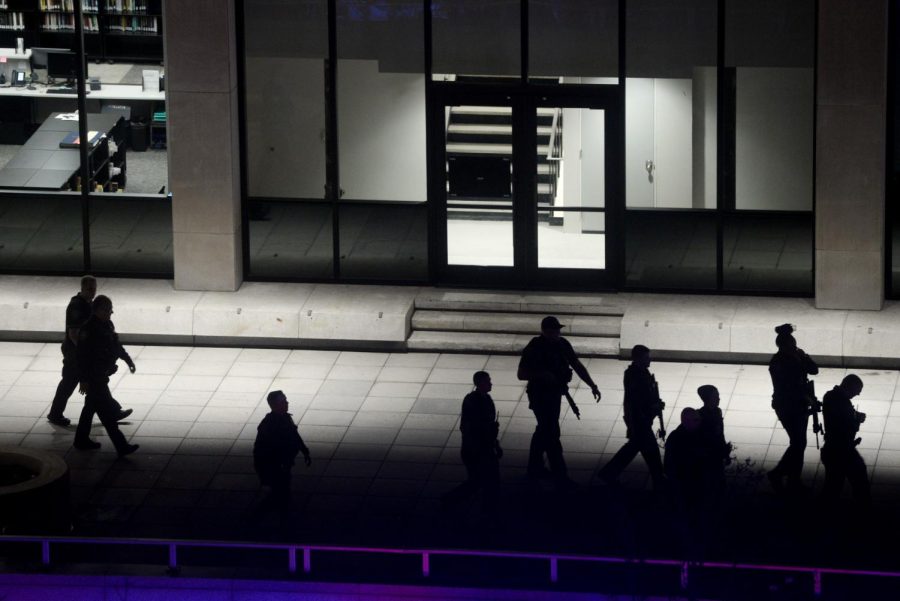Editorial | Pitt must improve its communication to students during emergencies
Police exit Hillman Library Monday night after evacuating students from the building.
April 12, 2023
Around 11:15 p.m. on Monday night, several members of our editorial board sat in The Pitt News office for what was supposed to be a typical production night. However, we were suddenly surprised to hear blaring sirens coming from outside, and when we peered out the office windows, we watched dozens of police cars surround Hillman Library while students ran out of the building.
From our office located on the fourth floor of the William Pitt Union, we watched hundreds of students bolt out of the library, some even jumping off of the side of the ramp out of fear. Police officers rushed inside with assault rifles to respond to alleged reports of an active shooter. At one point we even opened the window slightly to hear more of what was going on, but after hearing several loud sounds — which we presumed to be gunshots — we immediately shut the windows, turned off all the lights in the office, locked the door and crouched to continue to peer out the window.
This hoax happened not even two weeks after the hoax shooter at Central Catholic High School, and in a time when mass shootings are an unfortunate norm in the United States. While the incident was luckily a false alarm, the fear that students felt was very much real. Students in Hillman didn’t know that it was a hoax until after they evacuated the building.
As students watching things unfold, we were confused about what was happening, and then scared for our peers in Hillman. But, as student journalists, our second instinct was to find out what was going on and update the campus community with the information we had as soon as possible. We immediately tuned into the police scanner, started calling sources at the University to find out if there genuinely was an active shooter and texted friends to see if anyone was in the library.
The University didn’t provide any updates until more than an hour after the police first arrived at the library, in which it informed students that the calls reporting an active shooter were “unfounded and false.” The fact that students, who genuinely feared for their lives, had to wait so long for Pitt to send a single emergency alert is unacceptable.
ENS alerts are supposed to inform students of emergency situations on campus, but the only alert students received Monday night was ridiculously delayed. In an email the following morning, Ted Fritz, the vice chancellor for public safety and emergency management, said ENS alerts are “minimal and accurate and designed to give brief instruction on what you can do to keep yourself safe.” That is not what we witnessed Monday night.
Students didn’t hear from the University that there was a potential threat on campus or to stay away from the library — they only were informed after the threat was confirmed false. In fact, for many students, our social media posts and coverage were the first way they even found out that something was happening at all. This shows a clear lack of communication on the University’s part and a glaring problem with its ENS system.
While we understand that it’s crucial to provide students with accurate information and not alarm them too much, students were already frightened, and the fact that Pitt was not sending even an emergency notice to avoid Hillman is extremely disappointing. Many students have criticized the University and even started a petition for its lack of communication, and many more have even called into question what Pitt’s ENS alerts would have looked like had the incident been real.
Both Fritz and Chancellor Patrick Gallagher noted that the University is reassessing ENS and sharing information with the campus community since, according to Gallagher, it has proven “insufficient.” These assessments must be done quickly in case something like this, hoax or not, ever happens again.
As a student newspaper we will continue to update our campus community of events that happen on campus and do our best to share information we gather. But Pitt should have updated students way before we did. We ourselves are students, who feared for the lives of our friends and peers, and heard from Pittsburgh Public Safety before we heard from our own school.
While the fact that we even had a hoax call to begin with is problematic in itself and speaks to greater issues in American society, it’s even more disheartening that Pitt failed to communicate with students who experienced genuine fear. Pitt must do better for the safety and well-being of its students.



